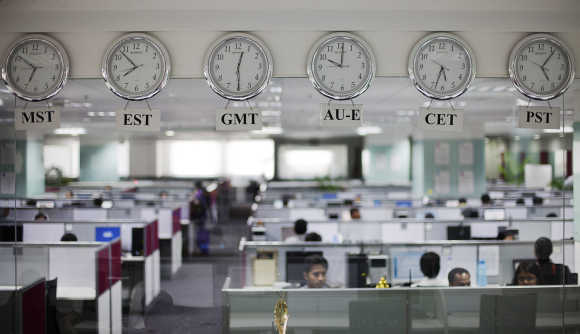 | « Back to article | Print this article |
'Service sector key to GDP and jobs'
India among developing nations is far ahead in becoming a service economy, says Uday Karmarkar, founder and director of the Anderson's Business and Information Technologies Project at the University of California, Los Angeles.
Karmarkar, who is an advisor to the Mumbai International School of Business Bocconi, says information economy in India will grow steadily and be the source of wealth for the educated.
Opportunities for students in information intensive sectors, such as financial services and ecommerce, will be substantial, says Karmarkar in an email interview to Faisal Kidwai.
You have said that the world is witnessing two major trends: The rise in service economy and information economy. What is information economy?
The "information economy" refers to everything in an economy that deals with the production and distribution of information goods and services. Information goods are products like books or data bases. Examples of information services are telecommunications, financial services, and education. Then there are the systems and appliances that process, transport and deliver information for both business and consumer markets.
So the information economy includes both services and products, though services are the larger part. It is possible to use national accounting data to estimate the sizes of different components of the economy in terms of GDP shares.
For example, in the US, services are over 85 per cent of total GDP, while the information economy comprises over 60 per cent of GDP. The intersection, or information intensive services, comprises over 50 per cent of the GDP in the US, and the picture is similar for countries like the UK and even Korea.
Click NEXT to read more...
'Service sector key to GDP and jobs'
Why are we seeing manufacturing shrink and services and information economy grow?
The growth is in services including (for now at least) those that are information intensive. The underlying reason is differing levels of productivity. Manufacturing as a sector has seen decades of productivity growth in every country. On the other hand, productivity growth in services has historically been much lower and slower to grow.
Higher productivity in a sector can at first result in dramatic growth, as with manufacturing in the industrial revolution, and with some new IT driven sectors today, like telecom, ecommerce or social networks. But eventually high productivity results in the decline of the sector in terms of share of GDP and employment. Simply put, as demand eventually satiates, and as it takes less to make more, less resources are needed.
This is the case with manufacturing in advanced countries today. For manufacturing jobs, since products can be easily shipped between locations, this trend is exacerbated by outsourcing and off-shoring. Low-cost locations take away some manufacturing jobs. Companies may not lose in this process, but employment is affected.
So even as Apple is flourishing as a US company, the jobs related to manufacturing their products are in China, South Korea, Taiwan, Japan and Thailand.
Click NEXT to read more...
'Service sector key to GDP and jobs'
Paradoxically, services with low productivity levels tend to grow in terms of both GDP share and total wage bill. Health care is a good example in almost every country. Low productivity means more jobs, and services become the largest source of job creation.
For most developed economies, over 70 per cent of the labour force is in services; for the US it is over 85 per cent. Furthermore, many services cannot be easily off-shored, and so are not subject to foreign competition. However, some information intensive services, like call centres and document management, can indeed be moved. There the US is losing jobs, while India is gaining them.
Are you witnessing these two trends in India, too?
Yes absolutely, but not yet at the same pace. India among developing nations is actually far ahead in becoming a service economy. This is good since services generate jobs. Now India also has good prospects for growth in manufacturing.
However, modern manufacturing requires world-class productivity, and so the job contribution of manufacturing will not be all that high. Still manufacturing output will grow and so will the number of jobs. But services will be the key for both output (GDP) as well as jobs in the near future.
Click NEXT to read more...
'Service sector key to GDP and jobs'
The big problem for India is of course that 60 per cent of labour is a rural and working in agriculture. Indian farms are very unproductive and 40 per cent are sub-marginal; farm size is actually decreasing and rural labour is stuck in a non-productive trap.
What is needed is a growth of efficient large-scale farming with a shift of labour from rural farms to services which also implies urbanisation. These services will not be information intensive, but rather physical, as in distribution, utilities, construction, transportation, retailing, hospitality, restaurants and the like.
However, it is not easy to see how this will happen, and it will take time. This is an area where government policies and actions have to be the crucial drivers. To summarise: 60 per cent of the Indian economy is already in services in terms of GDP and output, but 60 per cent of the labour force is in agriculture.
So, of course, wages in services are relatively high on average, while those in farming are desperately low. Manufacturing will grow, even boom, and is critical for exports. But is not the solution for jobs. As for the information economy in India, it will grow steadily and be the source of wealth for the educated.
Click NEXT to read more...
'Service sector key to GDP and jobs'
It will impact everybody, at the level of communication and interaction. Among developing economies, India is unusual in having many companies which are world class in their information technology expertise.
Within India, the information economy will take time to grow but will do so at a steady rate. The penetration of phones in India is already quite high at over 70 per cent and basic phones will be the main channel to customers for many businesses.
What is your advice to Indian students and companies on how to compete in this information economy?
The information economy is very relevant for students, since by definition they have access to education. The opportunities in information intensive sectors ranging from financial services, telecommunications, entertainment, publishing, ecommerce, business services, and education, will be substantial.
In addition there will be a growth in the information intensive portions of other businesses; for example, all businesses will become big users and buyers of information services. Companies in consumer oriented businesses will strive to exploit the phone channel first for advertising and later for delivery.
Click NEXT to read more...
'Service sector key to GDP and jobs'
Phone-based services will grow, limited only by the capability of phones, since smart phone adoption in India is still low due to high appliance costs. B2B and enterprise services are likely to grow faster.
For end consumers in India, entertainment and social networking will be very appealing. So will ecommerce, information search, and location services.
You are an advisor to the Mumbai International School of Business Bocconi - an initiative of Milan-based SDA Bocconi School of Management. Could you tell us a bit about MISB-Bocconi?
MISB-Bocconi, is poised to become one of the top management schools in India. It is the first appearance in India of a major global educational institution. Many other US and European schools have chosen to locate their Asian presence in places like Singapore, but Bocconi has seen the immense opportunity in India.
The model for MISB-Bocconi is also unique in the degree of commitment of Bocconi in terms of faculty presence; as of now most classes are being taught by Bocconi faculty.
Click NEXT to read more...
'Service sector key to GDP and jobs'
While there will be a growing Indian faculty at MISB, the relationship with Milano will remain close in both directions. Students will have the opportunity to visit Bocconi in Milano as well as Bocconi partner institutions all over the world.
Among the strengths of MISB will be in the very strong connection with corporations, both Indian and multinational, especially European. Their first class is already launched, and the students are of very high quality, since MISB is very selective in admissions.
Importantly, admissions are not driven simply by paper credentials and technical background. All entering students in the first class were interviewed and motivation, attitude, experience and maturity were all important selection criteria.
This will continue to be the case.






